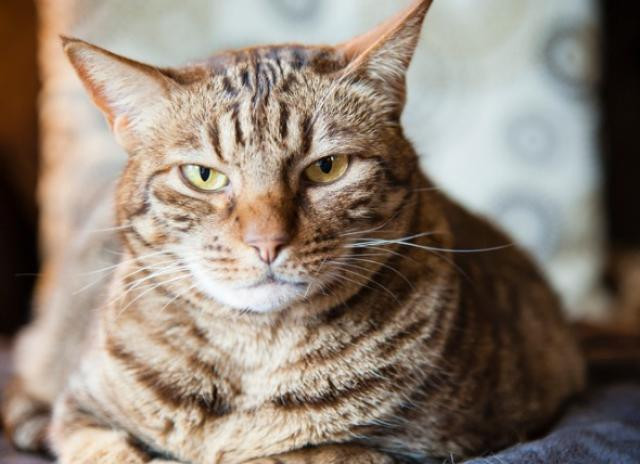Cats are enigmatic creatures, and their behaviors often leave us pondering their intentions. One common yet curious behavior is when your feline friend stares intently at you. While a prolonged gaze might feel impolite in human interactions, in the cat world, staring can be a multifaceted form of communication. Understanding why your cat is giving you that unwavering look can deepen your bond and improve your understanding of your pet’s needs and feelings. Let’s explore the various reasons behind a Staring Cat and learn how to interpret these silent signals.
Unpacking the Meanings Behind a Cat’s Gaze
A cat’s stare isn’t just a blank expression; it’s a way for them to communicate a range of messages. The context, combined with their body language, is key to deciphering what your staring cat is trying to tell you.
1. Seeking Your Attention and Interaction
Sometimes, a stare is simply your cat’s way of saying, “Hey, notice me!” When a cat wants your attention, they might employ a direct stare to make sure they have your focus. Once they’ve got your eyes locked, they might follow up with other attention-seeking behaviors. These can include a gentle slow blink, a soft meow, or even rubbing against furniture or rolling onto their back to appear extra cute and inviting. In these instances, your cat is likely hoping for some interaction, whether it’s petting, talking, or just acknowledging their presence.
 A fluffy white cat with blue eyes staring intently at the camera, showcasing a direct gaze for attention.
A fluffy white cat with blue eyes staring intently at the camera, showcasing a direct gaze for attention.
2. Initiating Playtime and Fun
If your cat’s stare is accompanied by a crouched posture, dilated pupils, and a tail swishing with anticipation, playtime is likely on their mind. This type of stare often precedes playful pounces or zoomies. You might see your staring cat suddenly dart towards you, perhaps aiming for your ankles (playfully, of course!) or diverting their course at the last moment. Some cats might even escalate the play by gently tackling your leg and engaging in bunny kicks – a clear invitation for some interactive fun. This intense gaze signals an energetic cat ready for some action and engagement with their favorite human.
3. Signaling Hunger and Mealtime Reminders
Cats are creatures of habit, especially when it comes to food. A persistent stare can be a strong indicator that your cat is reminding you about their feeding schedule. If you happen to make eye contact with a hungry cat, they might vocalize with meows or purrs and rub against your legs, further emphasizing their need for sustenance. They may then lead you towards their food bowl or the area where their food is typically stored. Alternatively, if you are eating, a staring cat might be hoping to snag a tasty tidbit of your meal, their gaze pleading for a share of your human food.
4. Expressing Fear and Alertness
Not all stares are friendly or playful. Sometimes, a cat’s stare can stem from fear or anxiety. If your cat is staring at a person, another animal, or an unfamiliar object with wide, dilated pupils, a lowered head, ears flattened to the side or back, a crouched body, and possibly raised fur (piloerection), they are likely in a state of fear. The stare in this context is a way for the cat to fixate on the source of their worry, constantly monitoring it for potential danger. Perhaps a sudden loud noise, a quick movement, or a memory of a negative experience has triggered this fearful response, and their stare is a sign of vigilance.
5. Demonstrating Affection and Trust
In the subtle language of cats, a soft, gentle stare, often accompanied by slow blinks, is a sign of affection and trust. This “cat kiss” is a way of telling you they feel safe and comfortable in your presence. By making eye contact and then deliberately closing their eyes, they are showing vulnerability, which, in the cat world, is a significant sign of trust. A slow blink often precedes a cat approaching you for attention, indicating a comfortable and affectionate interaction is desired.
6. Warning of Aggression and the Need for Space
Conversely, a hard, unblinking stare, combined with tense body language and piloerection along their back and tail, is a clear warning sign. This intense gaze is a threat, communicating that the cat needs space and will confront anyone who doesn’t back off. This type of stare is an aggressive signal directed towards another person or animal. It’s crucial to recognize this warning and give the cat distance to avoid potential aggression or attack.
Responding Appropriately to Your Staring Cat
Understanding the different meanings behind a cat’s stare is only half the equation; knowing how to respond is equally important. Your reaction should be guided by the context and your cat’s accompanying body language.
When a cat stares at you, take a moment to assess the situation and ask yourself:
- Is their body stiff, with raised fur and a rigid tail?
- Are their pupils dilated and large?
- Are their ears pinned back or to the side?
- Are they growling or hissing?
- Are they blinking softly and slowly?
If you observe signs of fear or aggression – stiffness, dilated pupils, flattened ears, growling – it’s crucial to avert your gaze, remain still, and slowly step back to give them more space. Avoid direct eye contact, talking to them, or attempting to pet them, as this could escalate their anxiety or aggression. Once you’ve created a safe distance of at least five feet, try to redirect their attention to something else, perhaps by gently tossing a cat toy away from you to distract them.
On the other hand, if your cat’s stare is accompanied by relaxed body language, soft blinks, and perhaps purring or rubbing, it’s a green light to approach and interact. You can reciprocate the affection by making eye contact and slow-blinking back to them, initiating petting, or engaging in play if that seems to be their intention.
By paying attention to the nuances of your cat’s stares and body language, you can become fluent in their silent communication, strengthening your bond and ensuring you’re meeting their emotional and physical needs effectively.


